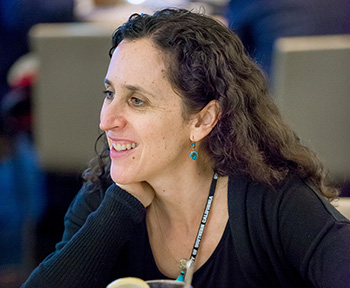
Yael Siman
Political scientist Yael Siman used to think she couldn’t be part of the Holocaust studies field because she’s not a historian. But after discovering USC Shoah Foundation’s Visual History Archive, she has embarked on her own research project and has even begun collaborating with the Institute’s education department on new lessons for university students.
Currently a professor in the department of international relations at Iberoamericana University in Mexico City, Siman first came across the Visual History Archive while studying for her PhD in political science at the University of Chicago. She attended a conference in 2014 while participating in a summer Holocaust education institute for university professors and there found out about the 55,000 testimonies of survivors of the Holocaust and other genocides in the Visual History Archive.
When she first began searching in the Visual History Archive, Siman focused on Holocaust survivors who had immigrated to Mexico and other Latin American countries. One of the first testimonies she watched was a survivor who had come to Argentina from Europe for work, not as a refugee, then continued on to Mexico and finally the United States. Siman was surprised to discover such a unique story of migration – one she had never known Holocaust survivors made.
As she dug deeper into the archive, Siman watched testimonies given by Holocaust survivors in Spanish. It was eye-opening for her to hear them speak about their wartime experiences influenced by their post-war lives in Latin America.
“It was fascinating to see them telling their stories using [Spanish-language] metaphors or idiomatic expressions or making comparisons from the Warsaw Ghetto to one of the worst, most crowded neighborhoods in Mexico City,” Siman said. “And to see how much they have internalized the local culture so they were referring to the past in Mexican ways or Chilean ways or Argentinean ways.”
She’s also been particularly interested in how survivors talk about their migration and acculturation in Latin America, how they were received by the locals, the challenges they faced, and how the national context of their new home may have influenced all of the above.
Siman will return later this summer for USC Shoah Foundation Center for Advanced Genocide Research’s 2017-2018 Interdisciplinary Research Group Fellowship. Siman and six other researchers will study the Visual History Archive’s testimonies of Holocaust survivors who immigrated to Latin America.
She was also one of more than a dozen representatives from Latin American education ministries invited to participate in USC Shoah Foundation and UNESCO’s professional development seminar for Latin American educators in September 2016. At the two-day event, Siman met USC Shoah Foundation education staff who invited her to return and help create new educational materials for IWitness.
Siman returned for a week this April to learn more about IWitness and the education department’s plans to develop more college-level resources for IWitness. Siman will now work on constructing lesson plans and activities that integrate testimony into a course she teaches called “Genocide and Crimes Against Humanity” in a deeper way than just showing one clip of testimony, as she has in the past. These activities and lessons could also be adapted for other university courses taught in English or Spanish. She’ll also find academic readings in English and Spanish that can support testimony-based activities in college classes.
Siman said she hopes these new teaching materials can serve as a model to help other departments, not just the history department, at universities around the world integrate testimony into their courses. Genocide survivor testimony offers personal stories that can enhance their studies in nearly any topic, as Siman has already seen in international relations.
“International relations students tend to look at the role of international governmental organizations and perhaps interactions between them at the international, national, and regional level, but I don’t think they go to the individual,” she said. “We cannot understand genocide or crimes against humanity completely if we isolate it from the experiences, trajectories and perspectives of individual victims and survivors.”